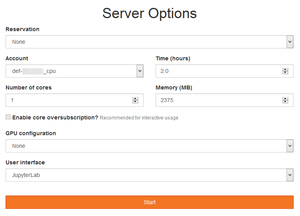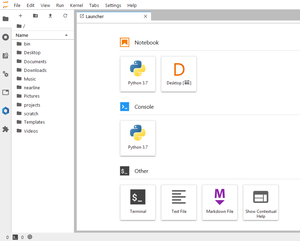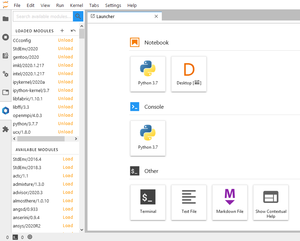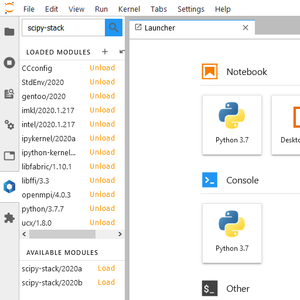JupyterLab: Difference between revisions
(No more a draft.) |
m (Fixed VS Code supported) |
||
| Line 135: | Line 135: | ||
[[File:JupyterLab_Launcher_VSCode.png|thumb|VS Code launcher button]] | [[File:JupyterLab_Launcher_VSCode.png|thumb|VS Code launcher button]] | ||
To enable the ''VS Code'' (Visual Studio Code) application launcher, a <code>code-server</code> module needs to be loaded. Depending on the software environment version, the latest version of VS Code should be loaded: | To enable the ''VS Code'' (Visual Studio Code) application launcher, a <code>code-server</code> module needs to be loaded. Depending on the software environment version, the latest version of VS Code should be loaded: | ||
* With <code>StdEnv/2020</code>, | * With <code>StdEnv/2020</code>, load module: code-server/3.5.0 | ||
* With <code>StdEnv/2018.3</code>, load module: <code>code-server/3.4.1</code> | * With <code>StdEnv/2018.3</code>, load module: <code>code-server/3.4.1</code> | ||
Revision as of 19:24, 22 January 2021
Introduction
JupyterLab is now the recommended general-purpose user interface to use on a JupyterHub. From a JupyterLab server, you can manage your remote files and folders, and you can launch Jupyter applications like a terminal, (Python 3) notebooks, RStudio and a Linux desktop.
The subsection JupyterHub on clusters contains the list of available Jupyter hubs at Compute Canada.
Launching a JupyterLab server as a job
On Béluga and Hélios, once the authentication is done on JupyterHub, your Web browser is redirected to either a) a previously launched Jupyter server or b) a form that allows you to configure and submit a new interactive session on the cluster. In any case, the JupyterLab server is running on dedicated compute resources.
In the Server Options form, you can:
- Set all compute resources options you need for the session
- Select JupyterLab as the User Interface
- Start the JupyterLab server by clicking the Start button
The JupyterLab Interface
When JupyterLab is ready to be used, the interface has multiple panels.
Menu bar on top
- In the File menu:
- Hub Control Panel: if you want to manually stop the JupyterLab server and the corresponding job on the cluster. This is useful when you want to start a new JupyterLab server with more or less resources
- Log Out: the JupyterHub session will end, which will also stop the JupyterLab server and the corresponding job on the cluster
- Most other menu items are related to notebooks and Jupyter applications
Tool selector on left
- File Browser (folder icon):
- This is where you can browse in your home, project and scratch spaces
- It is also possible to upload files
- Running Terminals and Kernels (stop icon):
- To stop kernel sessions and terminal sessions
- Commands
- Property Inspector
- Open Tabs:
- To navigate between application tabs
- To close application tabs - the corresponding kernels remain active
- Softwares (blue diamond sign):
- Compute Canada modules can be loaded and unloaded in the JupyterLab session. Depending on the module loaded, an icon directing to the Jupyter application will appear in the Launcher tab.
- The search box can search for any available module and give the result in the Available Modules sub-panel. Note: some modules are hidden until their dependency is loaded - we recommend that you first look for a specific module with
module spider module_namefrom a terminal. - The next sub-panel is the list of Loaded Modules in the whole JupyterLab session. Note: while
pythonandipython-kernelmodules are loaded by default, additional modules must be loaded before launching some other applications or notebooks. For example:scipy-stack. - The last sub-panel is the list of Available modules, similar to the output of
module avail. By clicking on a module's name, detailed information about the module is displayed. By clicking on the Load link, the module will be loaded and added to the Loaded Modules list.
Application area on right
- The Launcher tab is opened by default
- It contains all available Jupyter applications and notebooks, depending on which modules are loaded
Status bar at the bottom
- By clicking on the icons, this brings you to the Running Terminals and Kernels tool.
Jupyter Applications
JupyterLab offers access to a terminal, an IDE (Desktop), a Python console and different options to create text and Markdown files. This section presents only the main supported Jupyter applications that work with the Compute Canada software stack.
Terminal
This application launcher will open a terminal in a new JupyterLab tab:
- The terminal runs a (Bash) shell on the remote compute node without the need of an SSH connection
- Gives access to the remote filesystems (
/home,/project,/scratch) - Allows running compute tasks
- Gives access to the remote filesystems (
- The terminal allows copy-and-paste operations of text:
- Copy operation: select the text, then press Ctrl+C
- Note: usually, Ctrl+C is used to send a SIGINT signal to a running process, or to cancel the current command. To get this behaviour in JupyterLab's terminal, click on the terminal to deselect any text before pressing Ctrl+C
- Paste operation: press Ctrl+V
- Copy operation: select the text, then press Ctrl+C
Python 3.x (notebook)
If any of the following scientific Python packages is required by your notebook, before you open this notebook, you must load the scipy-stack module from the JupyterLab Softwares tool:
ipython,ipython_genutils,ipykernel,ipyparallelmatplotlibnumpypandasscipy- Other notable packages:
Cycler,futures,jupyter_client,jupyter_core,mpmath,pathlib2,pexpect,pickleshare,ptyprocess,pyzmq,simplegeneric,sympy,tornado,traitlets - And many more (click on the
scipy-stackmodule to see all Included extensions)
To open an existing Python notebook:
- Go back to the File Browser
- Browse to the location of the
*.ipynbfile - Double-click on the
*.ipynbfile:- This will open the Python notebook in a new JupyterLab tab
- An IPython kernel will start running in background for this notebook
To open a new Python notebook in the current File Browser directory:
- Click on the Python 3.x launcher under the Notebook section:
- This will open a new Python 3 notebook in a new JupyterLab tab
- A new IPython kernel will start running in background for this notebook
OpenRefine
To enable the OpenRefine application launcher, an openrefine module needs to be loaded. Depending on the software environment version, the latest version of OpenRefine should be loaded:
- With
StdEnv/2020, it is not yet supported - With
StdEnv/2018.3, load module:openrefine/3.3
This OpenRefine launcher will open or reopen an OpenRefine interface in a new Web browser tab:
- It is possible to reopen an active OpenRefine session after the Web browser tab was closed
- The OpenRefine session will end when the JupyterLab session will end
RStudio
To enable the RStudio application launcher, the following three modules need to be loaded:
gccrrstudio-server
Depending on the software environment version, you should load the following two modules (r is loaded automatically):
- With
StdEnv/2020, it is not yet supported - With
StdEnv/2018.3, load modules:gcc/7.3.0,rstudio-server/1.2.1335 - With
StdEnv/2016.4, load modules:gcc/7.3.0,rstudio-server/1.2.1335
This RStudio launcher will open or reopen an RStudio interface in a new Web browser tab:
- It is possible to reopen an active RStudio session after the Web browser tab was closed
- The RStudio session will end when the JupyterLab session will end
VS Code
To enable the VS Code (Visual Studio Code) application launcher, a code-server module needs to be loaded. Depending on the software environment version, the latest version of VS Code should be loaded:
- With
StdEnv/2020, load module: code-server/3.5.0 - With
StdEnv/2018.3, load module:code-server/3.4.1
This VS Code launcher will open or reopen the VS Code interface in a new Web browser tab:
- It is possible to reopen an active VS Code session after the Web browser tab was closed
- The VS Code session will end when the JupyterLab session will end
Desktop
This Desktop launcher will open or reopen a remote Linux desktop interface in a new Web browser tab:
- This is equivalent to running a VNC server on a compute node, then creating an SSH tunnel and finally using a VNC client, but you need nothing of all this with JupyterLab!
- It is possible to reopen an active desktop session after the Web browser tab was closed
- The desktop session will end when the JupyterLab session will end
Possible error messages
- A "time-out" error message when starting a JupyterLab session:
- Just like any interactive job on any cluster, the maximum time request should be under three (3) hours in order to avoid issues with the scheduler or a longer than usual wait time.
- There may be no available interactive node at the moment. You should then try at another moment.








